Uluru Dreaming
Another children’s tale
(We are the children of this sacred Mother Land)
As one might suspect for a place of such importance, Uluru has many Dreaming stories attached to it. No fewer than 10 ancestral beings play a part in Uluru’s creation. In fact, each side of Uluru has a different creation story with its own distinct lessons embedded within.
I headed this section “Another children’s tale” because the elements of the Dreaming I am about to relate, like all the Dreaming stories that appear in this blog, are the ones that Australia’s Indigenous People teach to their children when they are just beginning to learn what the Anangu call Tjukurpa – the lessons of creation, tradition, and law embedded in their Dreaming stories.
In much the same way that a child getting a western education will first learn basic arithmetic, eventually move on to algebra, and, perhaps finally to calculus, aboriginal children begin by learning a basic story with simple lessons. As they grow, layers will be added to increase their knowledge. As the child’s knowledge grows, so does their responsibility to care for Country and continue the group’s traditions. Unlike the teaching of mathematics, the Anangu can only share certain details with non-Aboriginal people. Thus all the Dreaming stories we read or here are edited and simplified.
The Kuniya and Liru story
I’m starting with this story not simply because we took the Kuniya walk during our time at Uluru but because from my perspective it is the most important or at least among the most important. One of the central elements in it is the creation of the Mutitjulu Waterhole.
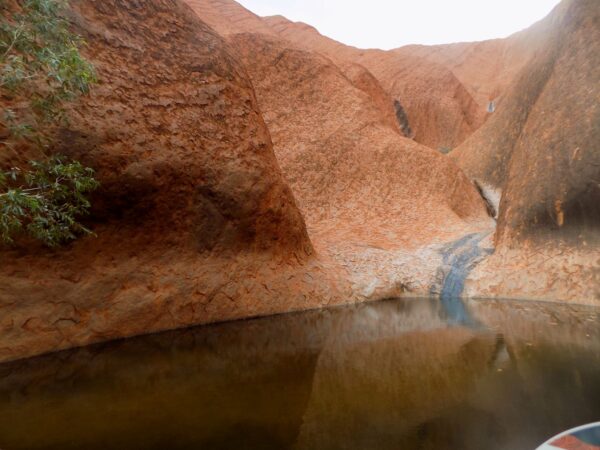
(I noted in the previous post that the desert oak tree provides a reliable source of water for the Anangu. However, it’s probably insufficient to sustain an entire population. The Mutitjulu Waterhole at Uluru is the only perennial surface water at Uluru. But even it must be carefully managed because the annual average evaporation rates are more than nine times greater than the average annual rainfall.)
The two main spirit ancestors of this tale took the form of snakes. Kuniya had the form of a giant woma python
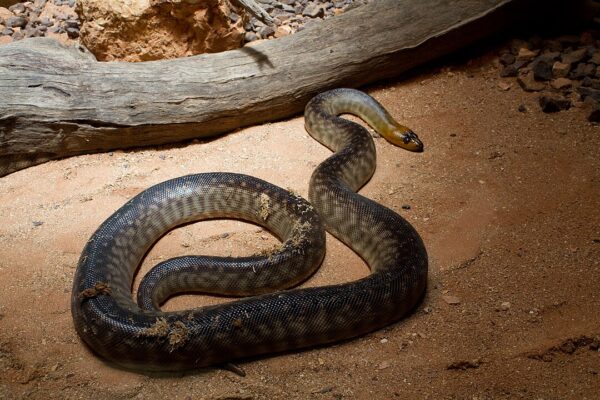
[From Wikipedia By Brian Gratwicke – Aspidites ramsayi Uploaded by Snowmanradio, CC BY 2.0.]
and Liru the venomous king brown snake.
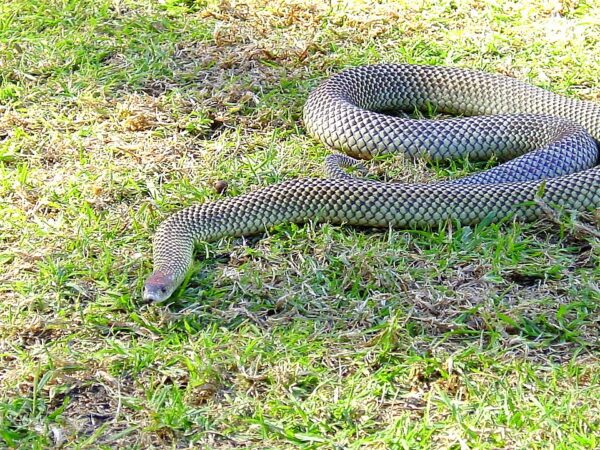
[From Wikipedia By F Delventhal from Outside Washington, D.C., US – Liru, CC BY 2.0.]
The story begins when the Minyma Kuniya (Kuniya woman) came to Uluru from far away in the east to hatch her children there. She left the eggs on the ground at a place called Kuniya Piti on the northeast corner of the monolith.
Kuniya camped at Taputji – an outcrop on the east side of Uluru and hunted in the nearby sandhills. As she left and entered her camp, she formed deep grooves in the rock that are still there. You can watch this very short video to pick up the next part of the story that involves her nephew.
The young Kuniya had offended the Liru in such a way that he deserved a form of punishment that would traditionally have been a spear through the thigh. However, once the punishment has been meted out, it then becomes the obligation of the Liru to tend to the injury until that person is well enough to care for themselves. The Liru were negligent in allowing the Kuniya to die.
Thus, when news of the young Kuniya’s death reached his aunt on the other side of Uluru, she was overcome with grief and anger. She raced along the curves of the rock to Mutitjulu Waterhole, where she confronted one of the Liru warriors, who mocked her grief and rage.
As her ire rose, Kuniya began a dance of immense power and magic. Moving toward the Wati Liru (venomous snake-man) warrior she scooped up sand and rubbed it over her body and it spread like a poison, saturating the area at that time.
She then took up her wana, or digging stick, and twice struck the head of the Liru. He dropped his shield near Mutitjulu Waterhole and died. The blows she struck are two deep cracks on the western wall, and the Liru’s shield, now a large boulder, lies where it fell.
One part of her remains as a sinuous black line on the eastern wall of Uluru
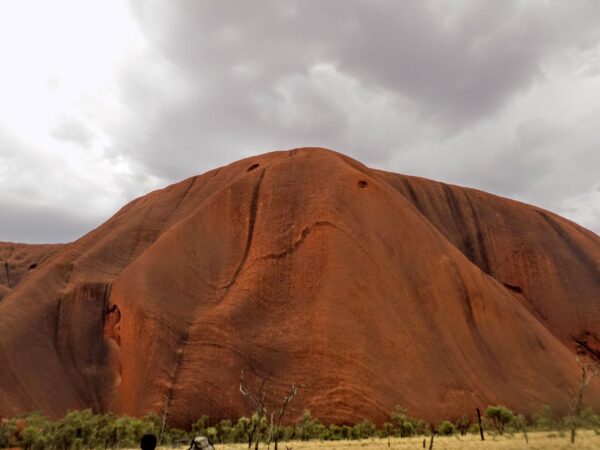
but she also combined her spirit with that of her nephew. Together they became Wanampi, the rainbow serpent. Wanampi resides in the Mutitjulu controlling and protecting the precious water source.
The Lungkata (Blue-Tongue Lizard) Story
Another important Dreaming story for the Anangu People is the story of Lungkata. This story is probably more important in the lessons it communicates than it is in regard to the creation of Uluru.
If Lungkata had not been lazy and greedy he might be seen as a positive figure in Anangu culture because as he traveled from the north he burned the Country and had he stopped there he would have taught only the lesson of using fire to manage the land. However, at Uluru, his true nature emerged.
As I read the story it seems that he was more of a scavenger than a hunter regularly preying on meat that others had hunted. But Lungkata always denied his thievery. On one of his expeditions from his cave high on the western face of the rock he encountered an emu dragging a spear. Even knowing that the bird belonged to other hunters, he killed the emu and began cooking and eating it.
The emu had been speared by two panpanpalala or bellbird hunters. (The bellbird is rather small weighing in at between 200 and 250 grams so the hunters would have likely considered themselves fortunate to find an emu that might weigh 50kg or more.)
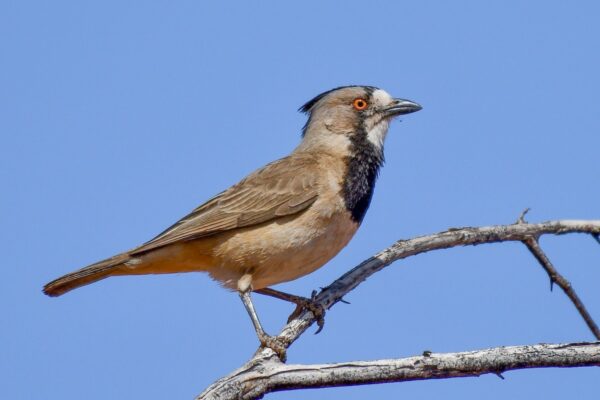
[From ebird.org – Copyright – Andreas Heikaus eBird S133273564Macaulay Library ML 560039541]
When they saw the smoke from Lungkata’s cooking fire they asked if he had seen the emu they had wounded. The blue-tongued lizard lied and told the hunters he had not.
As they retreated they came across the emu’s tracks and turned to once again confront Lungkata. The lizard had anticipated their return and was racing toward his camp carrying as much of the emu as he could but he also dropped pieces along the way. (The emu’s thigh is visible at Kalaya Tjunta, just north of the Ikari cave that is near the Mutitjulu Waterhole.)
Although he thought he was moving quickly, the lizard was actually slow and fat and the bellbird hunters caught him long before he could reach his cave. When they did, they lit a bonfire under him and the lizard began to choke on the smoke as he was burned by the flames.
As he rolled down the monolith, strips of his burned flesh stuck to the rocks he touched and he got smaller and smaller, ultimately becoming a small solitary stone.
The smoke and ash from the fire still stain the side of Uluru’s steep slopes above Lungkaṯa’s body and he became a lesson about the dangers inherent in greed, dishonesty, and even a symbol of the dangers in climbing Uluru.
Tourists were allowed to climb Uluru until 26 October 2019. I’ll have relate more about this in a later post. More than five years later, the trail they followed
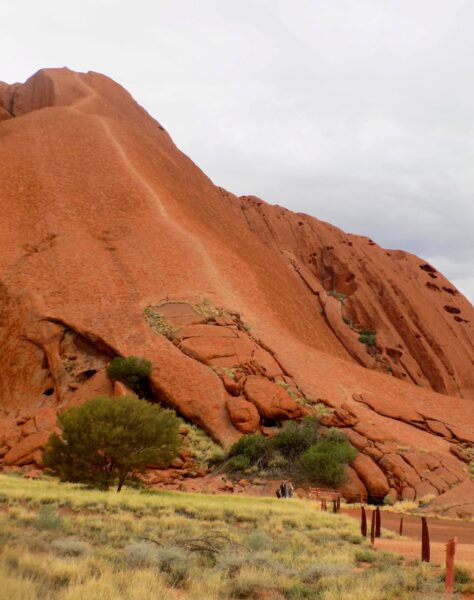
remains visible as the yellow stripe you can clearly see in the photo.
While you’re waiting for the next post about our brief stop at Kata Tjuta, feel free to amuse yourself by looking at some photos.